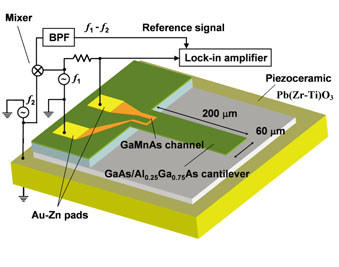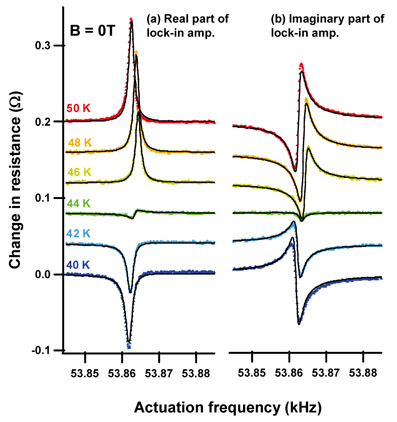1Physical Science Laboratory, 2Materials Science Laboratory
The piezoresistive effect (PR) is defined as the change
in resistance of a material due to an applied stress and is a fundamental
property of semiconductors and metals. In conventional semiconductors,
PR originates from a change in either carrier density or mobility. PR can
also be observed in metals, including ferromagnetic materials, due to geometrical
effects. PR provides a powerful tool for the investigation of electronic
transport properties and can be used for sensing applications. In this
study, we report a new mechanism of PR in GaMnAs where the ferromagnetic
ordering plays an essential role. We characterized PR by incorporating
a GaMnAs piezoresistor into a micromechanical cantilever and investigated
its temperature and magnetic field dependence at the ferromagnetic transition.
A clear ferromagnetic-induced piezoresistance component (FMPR) was found
below the Curie temperature (Tc) of our GaMnAs (Tc ~ 48 K). Figure 1 shows the schematic illustration of the cantilever together
with electrode on PZT and measurements setup. The frequency response of
PR is detected via down-mixing technique. The reference frequency can be
tuned by adjusting bias-current frequency (f1) and actuation frequency (f2). Figure 2 shows the temperature dependence of PR around Tc without external
magnetic field: (a) real part and (b) imaginary part. Data (dots) show
the measured frequency response, and the straight lines were obtained by
calculations. Data and calculated lines have been offset by Δ = 0.04 Ω
for clarity.
These results indicate that the FMPR of GaMnAs arises
from the perturbation of spontaneous spin ordering by the applied strain.
Moreover, the change in resistance is delayed with respect to mechanical
strain. We deduced a delay time of 230 ± 35 ns. The experimental
results presented indicate that the micromechanical method of characterizing
spin dynamics is complementary to conventional electrical and optical methods
[1].
[1] K. Onomitsu et al., Phys. Rev. B 87 (2013) 060410 (R).
 |
 |
|||||
|
|